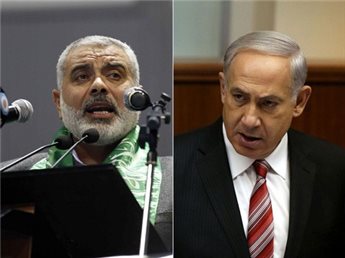Olmert and Abbas agree that with another few months’ time, they would have reached an agreement.
The international community is getting closer to the point where it will put down the terms of reference for an Israeli-Palestinian peace treaty. Whether it is in the form of a Palestinian-Jordanian proposal, a French-German-British proposal, an American proposal or any combination of the above, it will all include the same basic formula and will require Israel and Palestine to sit down once again at the negotiating table to try to reach an agreement. There can be no end of the occupation, recognition of a Palestinian state next to Israel, and peace, without an Israeli-Palestinian agreement. There will not be and there cannot be an imposed peace. Likewise, there cannot be another round of Israeli-Palestinian negotiations without clear terms of reference that can lead to an agreement.
There are so many myths and such general lack of knowledge surrounding every previous round of negotiations that it is hard not to come to the same conclusion that most Israelis and Palestinians hold – that reaching an agreement is impossible. The conventional wisdom according to most Israelis is that each time the Palestinians have been offered a generous offer by Israel they have walked away from the table. This includes the famous offer of the “whole store” by prime minister Ehud Barak at Camp David, which Yasser Arafat turned down, and the offer of prime minister Ehud Olmert to Palestinian Authority President Mahmoud Abbas, who, or so the story goes, turned it down and walked away.
Here are some of the facts: Barak’s Camp David offer of July 2000 included all of Gaza, 89 percent of West Bank with two east-west corridors under full Israeli control (dividing the West Bank into three cantons); Israeli control of the entirety of the eastern border of the Palestinian state and a security belt about five kilometers deep along the Green Line; a Palestinian capital in Abu Dis; no foothold in east Jerusalem or the Old City; and non-Palestinian Muslim control over the Aksa Mosque compound if Jews could build a synagogue on the Temple Mount.
There was no serious talk on the refugee issue at Camp David. Moreover, Barak never negotiated directly with Arafat at Camp David, despite the fact that he called for the leaders’ summit. He refused to directly negotiate with Arafat because the Americans demanded that a full and detailed American record be registered, and Barak refused.
The Palestinians called Barak’s proposal a “sovereign cage” and stated that there were deep gaps between the sides which required more time to work through. They agreed to continue negotiating after Camp David. Arafat was blamed by Barak for obstructing an agreement, with Barak claiming he had exposed Arafat’s “true face.” Nonetheless, even after the second intifada began on September 28, 2000, between Camp David and the Taba summit in January 2001 the Israeli and Palestinian negotiators met 52 more times. If Barak gave away the store at Camp David, as commonly believed, then what were they doing during these 52 subsequent meetings? Indeed, at the January 2001 Taba summit, which was held without the Americans, and without Barak and Arafat, the Israeli offer at Taba got to 96% of the West Bank; a Palestinian capital in east Jerusalem according to the Clinton parameters, which were given on December 23, 2000; several options for Palestinian refugees, with the emphasis on Palestinian return to the state of Palestine; and security arrangements in the Jordan Valley which did not include full Israeli control. In other words, a much better offer for the Palestinians. But then, 10 days prior to national elections in Israel, Barak ordered the team home and then lost the elections to Ariel Sharon, who won by a landslide.
Then Sharon unilaterally ceded all of Gaza to the Palestinian Authority, and Israel got Hamas and Kassam rockets in return. Sharon refused to negotiate or coordinate Israel’s withdrawal from Gaza with the Palestinian leadership under Abbas. Sharon insulted Abbas, calling him a “chick with no feathers,” and said that he was not a partner. No one should be surprised that Israel’s disengagement from Gaza was interpreted by the Arab street as supporting the narrative of those who preach violence against Israel, rather than of those who preach negotiation, diplomacy and non-violence.
Hamas in fact began firing rockets at Israel in 2002, three years before the withdrawal. Hamas won Gaza easily by emphasizing that Israel only responds to the language of force. This narrative of Hamas is still winning on the Arab street, even after the recent Gaza war.
Olmert and Abbas reportedly held 42 meetings dealing with every aspect of the conflict. They made enormous progress which culminated with an offer made by Olmert to Abbas in their last meeting. Olmert’s proposed included 93.7% of the West Bank to the Palestinian state, and Israeli annexation of 6.3% of the territory, including the main settlement blocs. Ariel, Ma’aleh Adumin and the Jewish parts of east Jerusalem were to be included under Israeli sovereignty. The territorial swaps would be on a 1:1 basis. No Palestinians would be annexed to Israel. A Gaza West-Bank link was part of the swap and was to be based on a tunnel under full Palestinian control. The Palestinian capital was to consist of all the Palestinian parts of east Jerusalem. All of the “holy basin” (Old City + area leading to the Mount of Olives) would be under control of an international body: Palestine, Saudi Arabia, Jordan, Israel and the US.
Olmert said that he was ready for 1,500 returnees to Israel a year for five years. Abbas requested that 150,000 refugees be allowed to return. Off the record Olmert has said that he would have agreed to 30,000. Olmert told Abbas that president Bush agreed to accept 100,000 refugees to the US.
An international force with some non-uniformed Israelis on the Jordanian side of the border was to have been part of the deal. Olmert had a detailed map for Abbas but insisted that Abbas sign the map and accept it. Abbas said that he could not accept that Ariel, 26 kilometers into the Palestinian state, remain part of Israel.
Olmert’s version of what happened: Olmert says that after he presented the plan to Abbas, chief Palestinian negotiator Saeb Erekat and Shalom Turjeman, Olmert’s political advisor, came into the room. They were presented with the plan and agreed that they would meet the following day. Later Erekat called Turjeman and said that he had meetings in Jordan or elsewhere and that he would call to set a new time to meet. No phone call came from Erekat. That was the last Olmert and his team heard from Abbas.
According to Abbas, Erekat and Turjeman agreed to meet in Washington, Erekat showed up but Turjeman did not. Soon afterward Olmert was indicted and was forced to step down. According to the Palestinians, US secretary of state Condoleezza Rice told them to stop negotiating with Olmert and to wait for Tzipi Livni. They also claim that Livni’s advisors told them the same thing. But Livni never became prime minister.
Olmert and Abbas agree that with another few months’ time, they would have reached an agreement.
The possibilities for reaching an Israeli-Palestinian agreement are based on closing the few gaps that existed at the end of the Olmert-Abbas negotiations. No agreement will be less than that. It should be recognized that the biggest gap between them was regarding territory, not Jerusalem or refugees. An agreement is still possible, but only when there is an Israeli prime minister willing to go the distance. Netanyahu is not that man, as he has proven. Netanyahu’s offers during the nine months of the Kerry initiative didn’t come close to something the Palestinians could accept.
I believe that the Herzog-Livni team would go the distance – maintaining a hawkish position on security issues and a dovish position on closing the territorial gaps. An agreement like that today would also open the door to wider regional security and stability plans that would enable Israel to confront the common threats from Islamic radicalism that face our neighbors.


